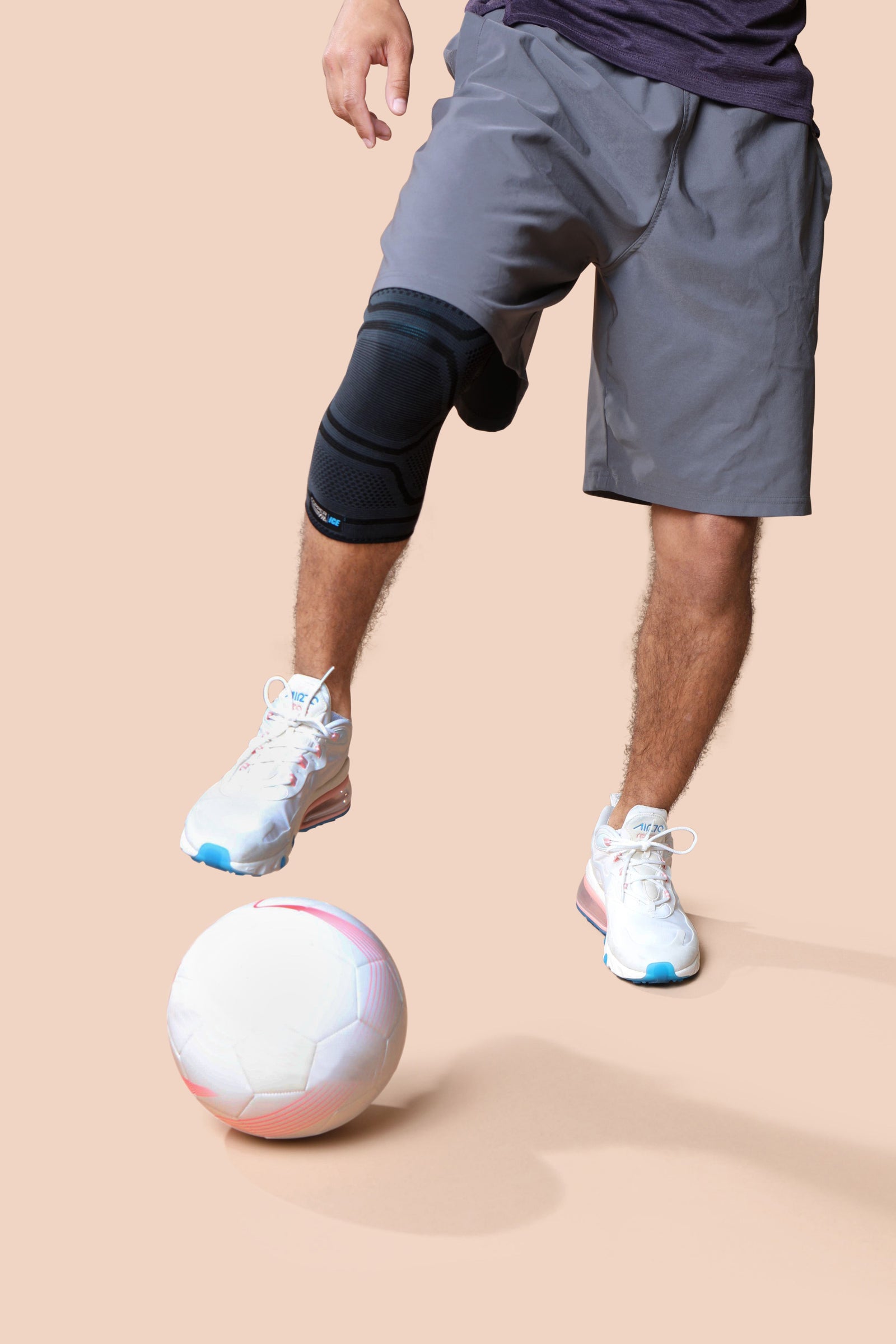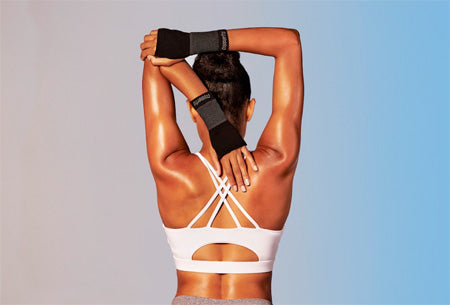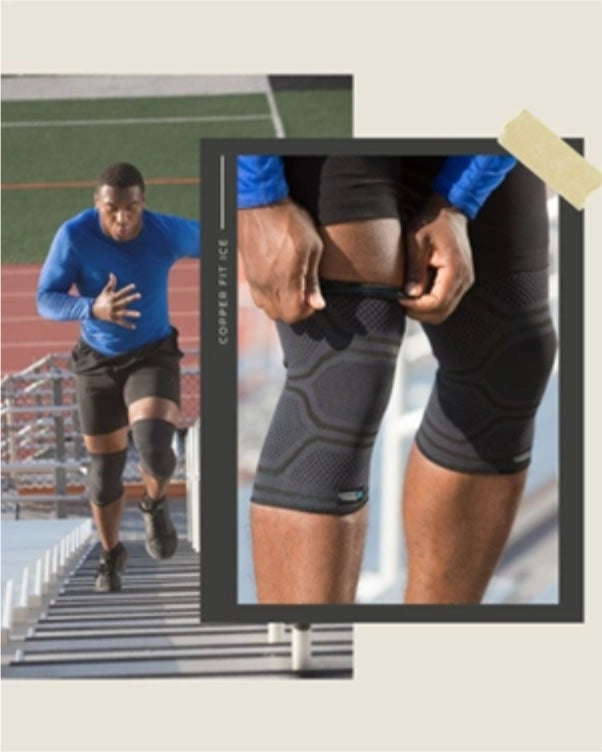
Key Takeaways
- A pulled hamstring is a mild strain where muscle fibers are overstretched, while a torn hamstring involves actual damage or separation of fibers.
- Understanding the difference helps you take the right recovery approach and avoid re-injury.
- Compression gear can help support healthy circulation, soothe muscle tension, and maintain comfort during both recovery and active movement.
If you’ve ever felt a sudden tightness or sharp pull in the back of your thigh during a run, workout, or even while bending down, you may have experienced a hamstring injury. Hamstring injuries are among the most common muscle strains for active adults and athletes alike. Two common types of injury are pulled and torn hamstrings.
But what exactly is the difference between a pulled and torn hamstring, and how can you tell the difference? Let’s get into it.
What Is the Hamstring?
Your hamstring is a group of three muscles located along the back of your thigh: the biceps femoris, semitendinosus, and semimembranosus. These muscles work together every time you bend your knee, extend your hip, or propel yourself forward when walking or running.
Because they’re so active in movement, the hamstrings are under constant tension. When you sprint, jump, or even take a sudden stride, they rapidly contract and lengthen. If those muscles aren’t adequately warmed up or are fatigued, the fibers can overstretch or tear.
What Can Cause Hamstring Injury?
Most hamstring strains occur when the muscle lengthens under stress. This happens during explosive activities like sprinting, jumping, or changing direction quickly. But it can also occur during a slower movement, like reaching too far during a stretch or slipping on an uneven surface.
Tight hip flexors, weak glutes, or muscle imbalances between the front and back of the thigh can also make the hamstrings more vulnerable. Previous injuries, which may leave scar tissue or weakened areas prone to re-strain, are another risk factor.
Low flexibility is another risk factor. Skipping warm-ups or forgoing stretching and strengthening exercises can increase the risk of hamstring injury, as it leaves the muscles less flexible. It’s common for hamstring injuries to occur when someone exerts themselves more than usual, or increases the intensity of their workouts too quickly without proper warmups or recovery periods.
Another factor is fatigue. When your muscles are tired, they become less efficient at absorbing force. That’s when a quick movement or stretch can cause damage. Even seasoned athletes experience this when they train without enough rest or hydration.
Many of these risks can be reduced with consistent conditioning, stretching, and strength training, proper hydration, and rest.
Pulled vs. Torn Hamstring: The Key Differences
A pulled hamstring is essentially a mild strain, where the muscle fibers are stretched beyond their natural range, but there’s minimal tearing. You might feel mild soreness or tightness, especially when bending your leg. There’s usually no bruising or swelling, just a sense of tension or discomfort that limits your range of motion slightly.
A torn hamstring, on the other hand, involves actual tearing of muscle fibers. This can be partial or complete. These injuries cause sharper soreness, noticeable swelling, and often bruising as blood vessels in the area rupture. You may hear a popping sound, and walking or bending the leg can be painful, and the muscle may feel weak or unstable.
|
Aspect |
Pulled Hamstring |
Torn Hamstring |
|
Severity |
Mild |
Moderate to Severe |
|
Fiber Damage |
Overstretched fibers |
Partial or complete tear |
|
Symptoms |
Tightness, mild soreness, slight tension |
Sharp soreness, bruising, swelling, limited movement |
|
Recovery Time |
A few days to 2 weeks |
Several weeks to months |
|
Common Cause |
Overstretching during exercise |
Sudden, forceful movement or trauma |
While the differences can sound concerning, both pulled and torn hamstrings share a positive reality: with the right recovery routine, your body can heal. Early rest, supportive compression, and a gradual return to movement all play an important role in preventing long-term issues.
Recognizing the Symptoms: How To Tell the Difference
It’s not always easy to tell if you’ve pulled or torn your hamstring, but knowing the signals of each can help. A pulled hamstring may start with a dull soreness or tightness that builds during or after activity. You might still be able to move, though it feels uncomfortable or stiff.
A torn hamstring feels more abrupt. Many people describe a sudden sharp sensation followed by swelling or bruising in the back of the thigh. In more severe cases, there might be a popping sound when the tear occurs. Movement becomes difficult, and the area may feel tender or weak.
If you experience severe swelling, bruising, or can’t bear weight comfortably, it’s best to see a healthcare professional. They can help assess the extent of the injury and recommend safe, effective treatment steps. Early diagnosis is important, as returning to activity too soon can prolong recovery and lead to re-injury.
When To See a Professional
A medical professional can determine whether your hamstring is pulled or torn through a physical exam, checking your range of motion, flexibility, and strength. In more serious cases, imaging tests such as an MRI or ultrasound may be used to identify the grade of strain.
Getting a proper diagnosis ensures you’re taking the right approach, because a mild pull may heal with rest and supportive care, while a more severe tear might need guided rehabilitation. Seeking help early supports faster recovery and helps protect long-term mobility.
Recovery: How To Heal a Pulled or Torn Hamstring
Recovering from a hamstring injury takes patience and consistency. While the body naturally repairs muscle tissue, the process benefits from the right balance of rest, gentle movement, and supportive care. Every stage of recovery plays a role in restoring strength and flexibility and preventing a repeat injury.
1. Initial Rest and Compression (First 48–72 Hours)
In the first few days after an injury, your focus should be on calming the affected area. Resting the muscle helps limit further strain, while light compression and cold therapy can help soothe discomfort. Using a compression sleeve or wrap during this phase can help support healthy circulation, bringing oxygen and nutrients to the area.
By applying gentle, consistent pressure to the area, compression gear can help the body’s natural recovery process by supporting blood flow and reducing fluid buildup. The result is less muscle tension and more comfort as the tissue begins to heal.
2. Rehabilitation and Movement
After the initial phase, gentle stretching and mobility work help restore flexibility. Start with light, pain-free movements, such as extending and bending the leg while seated, to help the muscle fibers realign. As recovery progresses, physical therapy or guided exercises can help rebuild strength and stability.
Strengthening the surrounding muscles—especially the glutes, hips, and quadriceps—also supports balance and reduces the risk of future strains. This stage is about listening to your body. Mild tension during recovery is normal, but sharp discomfort is a signal to pause and rest.
3. Return to Activity
Once the hamstring regains its strength and flexibility, a gradual return to movement is key. Start with low-impact exercises such as walking or cycling before resuming intense activities like sprinting or lifting.
This transition period is when re-injury risk is highest, so pacing yourself is key. Giving the muscle enough time to adapt prevents overstretching and ensures a smoother recovery. With steady progress, most mild strains heal fully within a few weeks, while more significant tears may take several months.
Prevention Tips: Staying Strong and Injury-Free
Hamstring injuries are often preventable with consistent care and awareness. A few key habits make a big difference:
-
Warm up before activity. Light cardio and dynamic stretches prepare muscles for movement and reduce stiffness.
-
Build balanced strength. Strong glutes and hamstrings help stabilize the hips and knees.
-
Stretch regularly. Consistent flexibility work keeps muscles resilient and responsive.
-
Stay hydrated and rest. Muscles perform best when they’re well-hydrated and given time to recover.
- Use compression support. Wearing compression sleeves during workouts helps maintain healthy circulation, supports the muscle structure, and can reduce post-activity soreness.
These small steps can help keep your muscles performing at their best and lower the chances of future strains.
When To Return to Exercise and How To Stay Motivated
You’ll know you’re ready to return to activity when your range of motion is back to normal, you can move without soreness, and your leg feels strong and stable. Take it slow—gradually increase activity levels instead of jumping back into intense exercise.
Staying motivated during recovery can be challenging, but each small improvement is progress. Focusing on movement quality, strength, and overall well-being helps you stay consistent. The goal is to rebuild strength safely, not to rush the process.
Frequently Asked Questions
How long does it take for a hamstring pull or tear to heal?
A mild hamstring pull may heal in one to two weeks, while a partial tear can take four to eight weeks. More severe tears might require several months of guided recovery. Healing time depends on the injury’s grade and how well you rest and support the muscle.
Can I stretch a pulled hamstring?
Gentle stretching can help once the initial soreness subsides, but it’s important not to stretch too early or too aggressively. Focus on controlled, pain-free movement and stop if you feel sharp discomfort.
Does compression gear really help with recovery?
Yes, compression helps promote healthy blood flow, which supports the body’s natural recovery process. It also provides stability and warmth that can help soothe tension and reduce post-activity soreness.
The Bottom Line
At Copper Fit, we believe recovery is part of every strong fitness routine. Our compression gear is designed to help support your body’s natural processes, supporting circulation, soothing muscle tension, and helping you move with comfort and confidence. Whether you’re recovering from a hamstring strain or working to prevent one, the right support can make all the difference.
We’re here to help you stay active, feel better, and keep doing what you love—every day.
Sources:
Hamstring Muscle: What It Is, Anatomy & Function | Cleveland Clinic
Risk factors and injury prevention strategies for hamstring injuries: a narrative review | PMC





